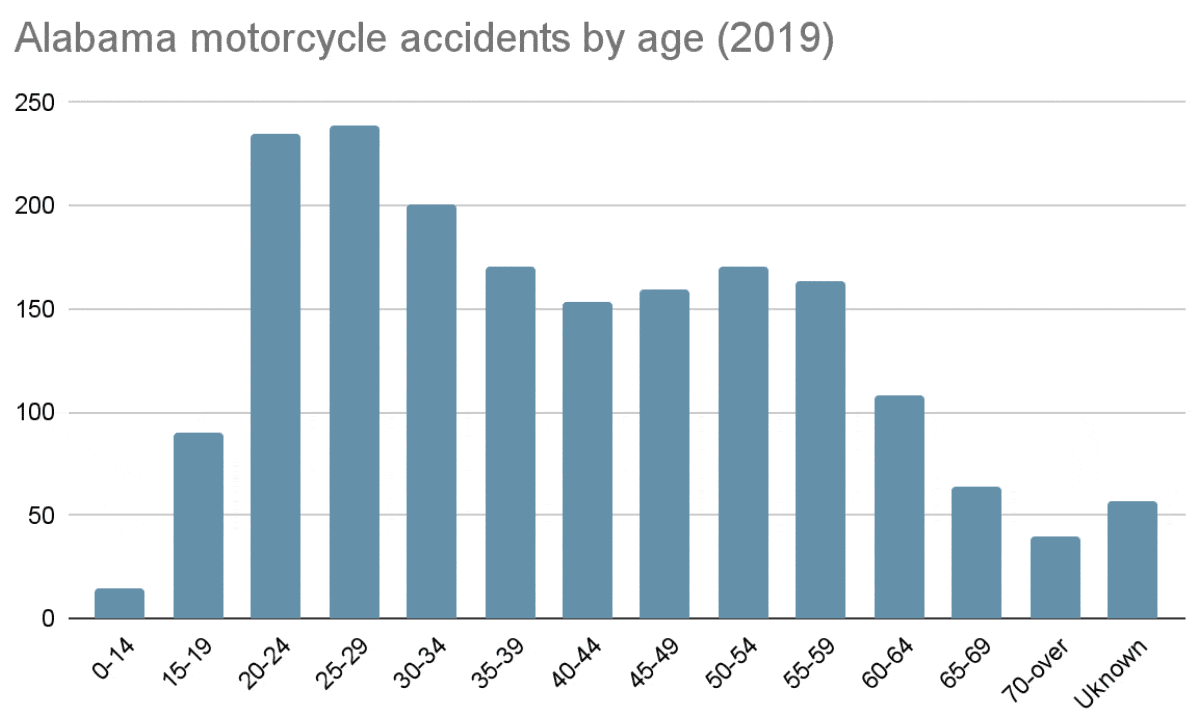How to recover damages after a motorcycle accident
Year-long warm weather and an abundance of rural roads make Alabama a popular state for motorcycle enthusiasts.
According to the United States Department of Transportation, there are more than 112,000 registered motorcycles in Alabama.
Although motorcycles are a great way to tour the Cotton State, they’re inherently more dangerous than cars. In this article, we’ll take a look at motorcycle accidents in Alabama, including the laws that might impact your injury claim and the steps you should take following a motorcycle crash.
How common are motorcycle accidents in Alabama?
Motorcyclists are 35 times more likely to get into a fatal accident than car drivers, according to the National Highway Traffic Safety Administration (NHTSA).
| Alabama motorcycle accidents (2015-2019) | |||
|---|---|---|---|
| Year | Motorcyclists | Injuries | Fatalities |
| 2015 | 1,601 | 1,254 | 74 |
| 2016 | 1,828 | 1,297 | 114 |
| 2017 | 1,918 | 1,222 | 79 |
| 2018 | 1,859 | 1,262 | 83 |
| 2019 | 1,867 | 1,213 | 90 |

Motorcycle license and registration requirements in Alabama
In order to operate a motorcycle in Alabama, you need to obtain a “Class M” motorcycle license.
Anyone 16 years of age or older is eligible to obtain a Class M motorcycle license. To do so, you’ll need to pass a written motorcycle test or complete an Alabama Traffic Safety Center Basic Rider course.
In addition, you’ll need to be able to provide the following documents:
- Identification (2 forms)
- Social Security card
- School enrollment form or proof of graduation (if younger than 19 and applying for the first time)
- $5 test fee (no checks)
- $36.25 to purchase a license (no checks)
Motorcycle insurance requirements in Alabama
Just like car drivers, all motorcyclists in Alabama are required to maintain the state’s minimum amount of liability insurance coverage, which is:
- $25,000 for bodily injury for the death of 1 person
- $50,000 for bodily injury for the death of 2 or more people in any 1 accident
- $25,000 for damage for the destruction of property in 1 accident
Keep in mind that liability insurance covers someone else’s injuries and property damage in an accident that you cause. To cover your own injuries and property damage, you’ll need to purchase optional coverage.
Motorcycle laws in Alabama
Alabama has passed several laws designed to keep motorcyclists (and other vehicle drivers who share the roads with motorcyclists) safe. Most of these laws can be found in Alabama Code Section 32-5A-240 through 245.
Here are the highlights:
Ala. Code § 32-5A-241(a). A person operating a motorcycle shall not carry a passenger unless the motorcycle is designed to carry the passenger.
Ala. Code § 32-5A-241(c). No person shall operate a motorcycle while carrying any package, bundle, or other article that prevents them from keeping both hands on the handlebars.
Ala. Code § 32-5A-242(b). The operator of a motorcycle must not overtake and pass in the same lane occupied by the vehicle being overtaken.
Ala. Code § 32-5A-242(c). No person shall operate a motorcycle between lanes of traffic or between adjacent lines or rows of vehicles (i.e. no lane splitting).
Ala. Code § 32-5A-242(d). Motorcycles shall not be operated more than 2 abreast in a single lane.
Ala. Code § 32-5A-243. No person riding upon a motorcycle shall attach himself or herself or the motorcycle to any other vehicle on a roadway.
Ala. Code § 32-5A-245. No person shall operate or ride upon a motorcycle unless they are wearing protective headgear and shoes.
Ala. Code § 32-5A-191. No person shall operate a motorcycle if they have a blood-alcohol content (BAC) of 0.08% or higher (for an adult) or .02% or higher (for a minor), or if they’re under the influence of alcohol or any other substance to a degree that renders them incapable of driving safely.
In addition to the statutory laws listed above, it’s important to keep in mind that all motorcyclists have a common law duty to exercise “reasonable care” to avoid harming others on the road while operating their motorcycles.
How to determine fault in an Alabama motorcycle accident
Motorcyclists and motor vehicle drivers have a legal duty to exercise reasonable care to avoid harming others on the road. If a motorcyclist or motor vehicle driver breaches this duty and an accident results, the at-fault party can be held liable.
The legal theory most often used to hold the at-fault party liable is negligence and it requires the plaintiff to establish 3 elements:
- The defendant owed the plaintiff a duty,
- The defendant breached their duty of care, and
- The breach was the legal cause of the plaintiff's injuries.
In the tragic event that a loved one is killed in a motorcycle accident, certain family members of the deceased can file a wrongful death lawsuit against the at-fault party. As is the case with a typical negligence claim, the family members will need to prove that the party being sued was responsible for the accident.
Often, the motorcyclist is at least partially at fault for their accident.
Although motorcycle accidents are usually caused by a motorcyclist or a motor vehicle driver, that's not always the case. There are a couple of other parties who may be liable for your accident:
- Property owners. Premises liability laws require property owners to maintain their property free of dangerous conditions. If a motorcyclist is injured as a result of a dangerous condition on someone's property, the property owner may be held liable.
- Manufacturers. Product liability laws require that manufacturers avoid letting defective products hit the marketplace. If a motorcyclist crashes as a result of a defective product (such as a defective brake system), the manufacturer of the product may be held liable.
Alabama follows the pure contributory negligence rule, which means that if a plaintiff is found to be even 1% at fault for their accident, they’re prohibited from recovering any damages.
Although it was a clear morning, Bobby’s face shield suddenly clouded with condensation, completely obscuring his vision.
"It was just like milk went in front of the mask; I couldn't even see at all."
Moments after his vision became obscured, he lost control of his motorcycle and struck an oncoming automobile. As a result of the collision, Bobby’s left elbow was shattered and his right foot severed. His right leg was later surgically amputated below the knee.
Bobby filed a lawsuit against Harley Davidson alleging that the helmet was defective because it lacked ventilation to prevent interior fogging and because it was not hinged so as to allow the user to quickly flip it up in the event visibility became inhibited.
At the end of a trial, the jury awarded Bobby $1 million.
Alabama motorcycle crash statute of limitations
All states require plaintiffs to file lawsuits within a certain period of time. The purpose of this time limit is to help improve the chances that relevant evidence is still available when a lawsuit is filed and to help prevent plaintiffs from threatening defendants with lawsuits indefinitely.
In Alabama, the time limitation (called the “statute of limitations“) for physical injuries is 2 years. This means motorcyclists injured in a crash have 2 years from the date of the crash to file a lawsuit. The time limitation for property damage is 6 years.
Types of damages available in an Alabama motorcycle accident
According to a report from the Government Accountability Office (GAO), motorcycle crashes cost more than $16 billion in direct costs, such as emergency services, medical costs, property damage, lost wages, and insurance every year.
The costs associated with non-fatal motorcycle accidents vary widely, typically ranging from $2,500 to $1.4 million depending on the injuries.
Fortunately, Alabama allows motorcycle accident victims to recover 3 types of damages:
- Economic damages represent the monetary losses caused by an accident (for example, medical expenses, lost wages, and property damage).
- Non-economic damages represent the non-monetary losses caused by an accident (for example, pain and suffering).
- Punitive damages are intended to punish the defendant. Punitive damages are only available in cases in which the defendant acted intentionally.
Staying safe on a motorcycle
Every year more than 5,000 motorcyclists are killed in motorcycle crashes across the country. Some accidents are unavoidable, but there are a couple of things you can do to improve your chances of making it home from a ride.
- Take a motorcycle safety course offered throughout Alabama by the University of Montevallo's Motorcycle Safety Program. Even if you took a safety course in order to obtain your motorcycle license, it’s a good idea to take a refresher course every so often.
- Review the ALEA Alabama Motorcycle Manual, which includes common motorcycle mistakes, safety tips, and pre-trip checklists.
- Happen at speeds greater than 35 miles per hour
- Happen at night
- Are caused by worn tires
- Involve riders who have less than 5 months of experience on their motorcycles
If you or a loved one were injured in a motorcycle accident, don’t hesitate to schedule an initial consultation with a personal injury attorney. Most initial consultations are free and you can locate an Alabama attorney near you using our free online directory.
Did you know that motorcycle accident law varies by state?
Need a lawyer?
What does an injury lawyer do?
A personal injury lawyer helps individuals who have sustained injuries in accidents to recover financial compensation. These funds are often needed to pay for medical treatment, make up for lost wages and provide compensation for injuries suffered. Sometimes a case that seems simple at first may become more complicated. In these cases, consider hiring an experienced personal injury lawyer. Read more














